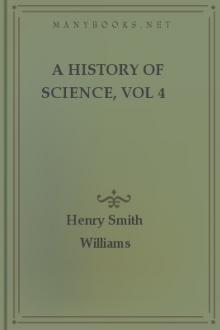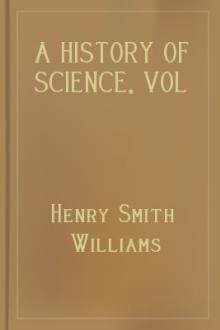A History of Science, vol 2, Henry Smith Williams [read this if txt] 📗

- Author: Henry Smith Williams
- Performer: -
Book online «A History of Science, vol 2, Henry Smith Williams [read this if txt] 📗». Author Henry Smith Williams
Only a comparatively small part of his philosophical writings concern us here. According to his theory of the ultimate elements of the universe, the entire universe is composed of individual centres, or monads. To these monads he ascribed numberless qualities by which every phase of nature may be accounted. They were supposed by him to be percipient, self-acting beings, not under arbitrary control of the deity, and yet God himself was the original monad from which all the rest are generated. With this conception as a basis, Leibnitz deduced his doctrine of pre-established harmony, whereby the numerous independent substances composing the world are made to form one universe. He believed that by virtue of an inward energy monads develop themselves spontaneously, each being independent of every other.
In short, each monad is a kind of deity in itself—a microcosm representing all the great features of the macrocosm.
It would be impossible clearly to estimate the precise value of the stimulative influence of these philosophers upon the scientific thought of their time. There was one way, however, in which their influence was made very tangible—namely, in the incentive they gave to the foundation of scientific societies.
SCIENTIFIC SOCIETIES
At the present time, when the elements of time and distance are practically eliminated in the propagation of news, and when cheap printing has minimized the difficulties of publishing scientific discoveries, it is difficult to understand the isolated position of the scientific investigation of the ages that preceded steam and electricity. Shut off from the world and completely out of touch with fellow-laborers perhaps only a few miles away, the investigators were naturally seriously handicapped; and inventions and discoveries were not made with the same rapidity that they would undoubtedly have been had the same men been receiving daily, weekly, or monthly communications from fellow-laborers all over the world, as they do to-day. Neither did they have the advantage of public or semi-public laboratories, where they were brought into contact with other men, from whom to gather fresh trains of thought and receive the stimulus of their successes or failures. In the natural course of events, however, neighbors who were interested in somewhat similar pursuits, not of the character of the rivalry of trade or commerce, would meet more or less frequently and discuss their progress. The mutual advantages of such intercourse would be at once appreciated; and it would be but a short step from the casual meeting of two neighborly scientists to the establishment of “societies,” meeting at fixed times, and composed of members living within reasonable travelling distance. There would, perhaps, be the weekly or monthly meetings of men in a limited area; and as the natural outgrowth of these little local societies, with frequent meetings, would come the formation of larger societies, meeting less often, where members travelled a considerable distance to attend. And, finally, with increased facilities for communication and travel, the great international societies of to-day would be produced—the natural outcome of the neighborly meetings of the primitive mediaeval investigators.
In Italy, at about the time of Galileo, several small societies were formed. One of the most important of these was the Lyncean Society, founded about the year 1611, Galileo himself being a member. This society was succeeded by the Accademia del Cimento, at Florence, in 1657, which for a time flourished, with such a famous scientist as Torricelli as one of its members.
In England an impetus seems to have been given by Sir Francis Bacon’s writings in criticism and censure of the systern of teaching in colleges. It is supposed that his suggestions as to what should be the aims of a scientific society led eventually to the establishment of the Royal Society. He pointed out how little had really been accomplished by the existing institutions of learning in advancing science, and asserted that little good could ever come from them while their methods of teaching remained unchanged. He contended that the system which made the lectures and exercises of such a nature that no deviation from the established routine could be thought of was pernicious. But he showed that if any teacher had the temerity to turn from the traditional paths, the daring pioneer was likely to find insurmountable obstacles placed in the way of his advancement.
The studies were “imprisoned” within the limits of a certain set of authors, and originality in thought or teaching was to be neither contemplated nor tolerated.
The words of Bacon, given in strong and unsparing terms of censure and condemnation, but nevertheless with perfect justification, soon bore fruit. As early as the year 1645 a small company of scientists had been in the habit of meeting at some place in London to discuss philosophical and scientific subjects for mental advancement. In 1648, owing to the political disturbances of the time, some of the members of these meetings removed to Oxford, among them Boyle, Wallis, and Wren, where the meetings were continued, as were also the meetings of those left in London. In 1662, however, when the political situation bad become more settled, these two bodies of men were united under a charter from Charles II., and Bacon’s ideas were practically expressed in that learned body, the Royal Society of London. And it matters little that in some respects Bacon’s views were not followed in the practical workings of the society, or that the division of labor in the early stages was somewhat different than at present. The aim of the society has always been one for the advancement of learning; and if Bacon himself could look over its records, he would surely have little fault to find with the aid it has given in carrying out his ideas for the promulgation of useful knowledge.
Ten years after the charter was granted to the Royal Society of London, Lord Bacon’s words took practical effect in Germany, with the result that the Academia Naturae Curiosorum was founded, under the leadership of Professor J. C. Sturm. The early labors of this society were devoted to a repetition of the most notable experiments of the time, and the work of the embryo society was published in two volumes, in 1672 and 1685 respectively, which were practically text-books of the physics of the period. It was not until 1700 that Frederick I. founded the Royal Academy of Sciences at Berlin, after the elaborate plan of Leibnitz, who was himself the first president.
Perhaps the nearest realization of Bacon’s ideal, however, is in the Royal Academy of Sciences at Paris, which was founded in 1666
under the administration of Colbert, during the reign of Louis XIV. This institution not only recognized independent members, but had besides twenty pensionnaires who received salaries from the government. In this way a select body of scientists were enabled to pursue their investigations without being obliged to “give thought to the morrow” for their sustenance. In return they were to furnish the meetings with scientific memoirs, and once a year give an account of the work they were engaged upon. Thus a certain number of the brightest minds were encouraged to devote their entire time to scientific research, “delivered alike from the temptations of wealth or the embarrassments of poverty.” That such a plan works well is amply attested by the results emanating from the French academy. Pensionnaires in various branches of science, however, either paid by the state or by learned societies, are no longer confined to France.
Among the other early scientific societies was the Imperial Academy of Sciences at St. Petersburg, projected by Peter the Great, and established by his widow, Catharine I., in 1725; and also the Royal Swedish Academy, incorporated in 1781, and counting among its early members such men as the celebrated Linnaeus. But after the first impulse had resulted in a few learned societies, their manifest advantage was so evident that additional numbers increased rapidly, until at present almost every branch of every science is represented by more or less important bodies; and these are, individually and collectively, adding to knowledge and stimulating interest in the many fields of science, thus vindicating Lord Bacon’s asseverations that knowledge could be satisfactorily promulgated in this manner.
X. THE SUCCESSORS OF GALILEO IN PHYSICAL SCIENCE
We have now to witness the diversified efforts of a company of men who, working for the most part independently, greatly added to the data of the physical sciences—such men as Boyle, Huygens, Von Gericke, and Hooke. It will be found that the studies of these men covered the whole field of physical sciences as then understood—the field of so-called natural philosophy. We shall best treat these successors of Galileo and precursors of Newton somewhat biographically, pointing out the correspondences and differences between their various accomplishments as we proceed.
It will be noted in due course that the work of some of them was anticipatory of great achievements of a later century.
ROBERT BOYLE (1627-1691)
Some of Robert Boyle’s views as to the possible structure of atmospheric air will be considered a little farther on in this chapter, but for the moment we will take up the consideration of some of his experiments upon that as well as other gases. Boyle was always much interested in alchemy, and carried on extensive experiments in attempting to accomplish the transmutation of metals; but he did not confine himself to these experiments, devoting himself to researches in all the fields of natural philosophy. He was associated at Oxford with a company of scientists, including Wallis and Wren, who held meetings and made experiments together, these gatherings being the beginning, as mentioned a moment ago, of what finally became the Royal Society.
It was during this residence at Oxford that many of his valuable researches upon air were made, and during this time be invented his air-pump, now exhibited in the Royal Society rooms at Burlington House.[1]
His experiments to prove the atmospheric pressure are most interesting and conclusive. “Having three small, round glass bubbles, blown at the flame of a lamp, about the size of hazel-nuts,” he says, “each of them with a short, slender stem, by means whereof they were so exactly poised in water that a very small change of weight would make them either emerge or sink; at a time when the atmosphere was of convenient weight, I put them into a wide-mouthed glass of common water, and leaving them in a quiet place, where they were frequently in my eye, I observed that sometimes they would be at the top of the water, and remain there for several days, or perhaps weeks, together, and sometimes fall to the bottom, and after having continued there for some time rise again. And sometimes they would rise or fall as the air was hot or cold.”[2]
It was in the course of these experiments that the observations made by Boyle led to the invention of his “statical barometer,”
the mercurial barometer having been invented, as we have seen, by Torricelli, in 1643. In describing this invention he says: “Making choice of a large, thin, and light glass bubble, blown at the flame of a lamp, I counterpoised it with a metallic weight, in a pair of scales that were suspended in a frame, that would turn with the thirtieth part of a grain. Both the frame and the balance were then placed near a good barometer, whence I might learn the present weight of





Comments (0)